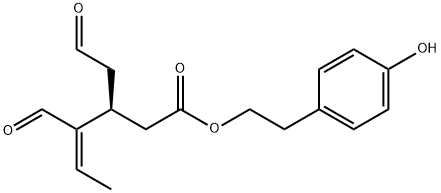ChEBI: A carboxylic ester that is the 2-(p-hydroxyphenyl)ethyl ester of (3S)-4-formyl-3-(2-oxoethyl)hex-4-enoic acid. Oleocanthal is found in olive oil but it is not clear whether the natural product is a mixture of E
Oleocanthal is one of the important polyphenols of olive oil well-known for its biological properties and health benefits. It exerts anti-inflammatory activity due to its dose-dependent inhibition of cyclooxygenase (COX-1, COX-2) enzymes in the prostaglandin biosynthesis in the same pathway as Ibuprofen. Oleocanthal is a potent anti-cancer agent, its treatment demonstrates inhibition of proliferation, migration, and invasion of various human breast cancer, prostate cancer, and multiple myeloma cells. In non-melanoma skin cancer, it reduces cell viability and migration, through inhibition of Erk and Akt phosphorylation and suppression of B-Raf expression. Oleocanthal was found to modulate estrogen receptor expression in luminal breast cancer and acts synergistically with tamoxifen treatment. It also elicits neuroprotective properties by inhibiting the formation of neurofibrillary tangles, a key hallmark in the pathogenesis of Alzheimerμs disease. Oleocanthal has also been reported to increase Amyloid-β transport across the blood-brain barrier via P-glycoprotein induction. It was found th at it acts synergistically with Donepezil, an acetylcholine esterase inhibitor approved for use for all Alzheimerμs disease stages. Oleuropein displays anti-leishmanial activity when added in vitro and in vivo, in experimental models of Leishmania infection.
